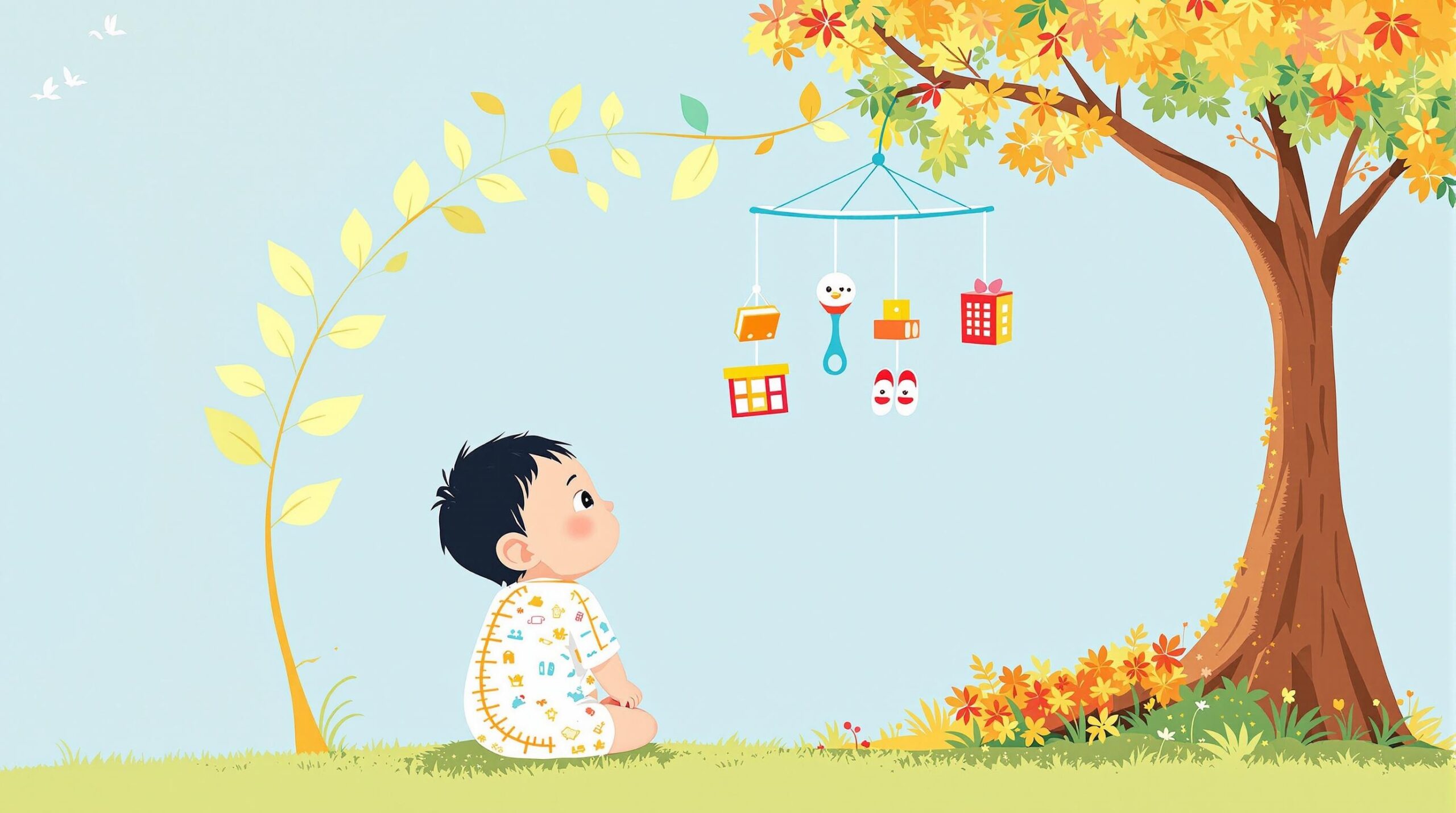Table of Contents
ToggleAs a parent, watching your baby grow and develop is one of life’s most incredible experiences. However, it can also be a time filled with questions and concerns, especially when it comes to understanding your baby’s growth spurts. These periods of rapid development are crucial for your little one’s physical and cognitive progress, but they can also bring challenges for both you and your baby. In this comprehensive guide, I’ll walk you through everything you need to know about baby growth spurts, from what to expect to how you can best support your child during these exciting times.
The Basics of Baby Growth Spurts
Growth spurts are intense periods of rapid physical and cognitive development in babies. These spurts typically occur at specific ages: 2-3 weeks, 6 weeks, 3 months, 6 months, and 9 months. However, each baby follows their own growth pattern, and your little one might experience growth spurts at slightly different times.
During a growth spurt, which can last anywhere from a few days to a week, you might notice several changes in your baby’s behavior and needs. These can include:
- Increased appetite: Your baby may want to feed more frequently or for longer periods.
- Changes in sleep patterns: Some babies might sleep more, while others might have trouble settling down.
- Fussiness: Your usually content baby might become more irritable or clingy.
- Physical changes: You might notice your baby outgrowing clothes or diapers more quickly.
Understanding these signs can help you prepare for and navigate through your baby’s growth spurts with more confidence and patience.

Understanding Developmental Stages
To truly appreciate the significance of growth spurts, it’s helpful to understand the broader context of developmental stages. One of the most influential theories in this area comes from psychologist Jean Piaget, who proposed four distinct stages of cognitive development:
Sensorimotor Stage (0-2 years)
This stage aligns closely with the period when your baby will experience most of their growth spurts. During this time, babies learn about the world through their senses and movements. A key development during this stage is object permanence – the understanding that objects continue to exist even when they can’t be seen.
For example, you might notice your baby looking for a toy that’s been hidden under a blanket, demonstrating their growing understanding of object permanence. This cognitive leap is often accompanied by physical growth spurts, as your baby’s brain makes new connections and their body grows to support new abilities.
Preoperational Stage (2-7 years)
While this stage extends beyond the typical growth spurt period, it’s important to understand as it builds on the foundations laid during the earlier months. In this stage, children develop language skills and begin to engage in symbolic thought.
You’ll see your child start to use words and play pretend, important cognitive milestones that are supported by the physical growth and brain development that occurred during earlier growth spurts.
Key Developmental Milestones During Growth Spurts
Growth spurts aren’t just about physical changes – they’re also periods of significant cognitive, motor, and social development. Here are some key milestones to look out for:
Gross Motor Skills
By around 60 months, most children can catch a ball, balance on one foot, and skip. These skills develop gradually, with each growth spurt potentially bringing new abilities. For instance, during the 3-month growth spurt, you might notice your baby starting to lift their head during tummy time, a precursor to later gross motor skills.
Fine Motor Skills
Around 60 months, children typically can copy shapes, draw recognizable pictures, and use a mature pencil grasp. These skills start developing much earlier, though. During the 6-month growth spurt, you might see your baby starting to reach for and grasp objects, laying the foundation for later fine motor control.
Communication Skills
By 60 months, most children can recall parts of a story, use future tense, and speak clearly enough for strangers to understand them. This journey begins during early growth spurts, with babies starting to coo and babble, responding to voices, and eventually saying their first words.
Cognitive Skills
Around 60 months, children typically can name colors, show interest in letters and numbers, and understand basic counting. These skills build on earlier cognitive developments that occur during growth spurts, such as recognizing familiar faces, understanding cause and effect, and showing curiosity about their environment.
Remember, these milestones are general guidelines. Every child develops at their own pace, and what to expect month by month can vary. If you have concerns about your child’s development, it’s always best to consult with your pediatrician.
Emotional and Social Development During Growth Spurts
While physical and cognitive changes are often the most noticeable during growth spurts, emotional and social development is equally important. Here’s what you might observe:
Stranger and Separation Anxiety
Around 9 months, many babies start to show signs of stranger anxiety and separation anxiety. This coincides with a common growth spurt and is actually a positive sign of cognitive development – your baby now recognizes familiar faces and understands object permanence, realizing that when you leave, you’re gone.
You might notice your usually social baby becoming clingy or upset when unfamiliar people approach. This is perfectly normal and typically peaks around 18 months before gradually decreasing.
Emotional Expression
As your baby grows, their ability to express emotions becomes more sophisticated. By 60 months, most children can play away from parents for short periods and discuss their feelings. This journey begins during early growth spurts when babies start to smile socially, laugh, and show distress.
Temper Tantrums
Between 1 and 2 years, coinciding with several growth spurts, temper tantrums become common. These outbursts often stem from frustration as your child’s desire to do things independently outpaces their actual abilities. While challenging, tantrums are a normal part of emotional development.
Supporting your child’s emotional and social development during growth spurts involves patience, consistency, and lots of love. Providing a secure base for your child to explore from, and return to when feeling overwhelmed, is crucial.
The Role of Parents in Supporting Growth Spurts
As a parent, you play a crucial role in supporting your baby through growth spurts. Here’s how you can make a positive impact:
Engaging in Developmental Activities
Participate in activities that promote learning and safety. During physical growth spurts, provide opportunities for safe exploration and movement. For cognitive growth spurts, engage in activities like reading, singing, and playing games that encourage problem-solving.
Open Communication
As your child grows, maintain open lines of communication. This becomes especially important when discussing online safety as they get older. Start early by narrating your actions and encouraging your baby to communicate in whatever way they can.
Creating a Supportive Environment
Ensure your home is a safe and stimulating environment for your growing baby. This might mean childproofing during early growth spurts and later providing age-appropriate toys and books that challenge your child’s developing skills.
Remember, your consistent presence and support are invaluable during these periods of rapid change. Your baby looks to you for comfort and guidance as they navigate new experiences and abilities.
Monitoring Your Baby’s Development
While it’s important not to obsess over every detail, keeping an eye on your baby’s development can help you spot any potential issues early. Here’s how to do it effectively:
Developmental Surveillance
This involves ongoing monitoring of your child’s development to identify potential problems early. You can do this by:
- Observing your child’s behavior and skills regularly
- Noting any concerns or questions to discuss with your pediatrician
- Comparing your child’s progress to general milestone guidelines, while remembering that all children develop at their own pace
Anticipatory Guidance
This is about preparing for and managing developmentally appropriate behaviors. For instance, knowing that separation anxiety often peaks around 18 months can help you prepare strategies to ease transitions.
Regular Check-ups
Your baby’s first doctor visit is just the beginning. Regular pediatric check-ups are crucial for monitoring growth and development. These visits allow your doctor to track your baby’s progress and address any concerns you might have.
Tracking Milestones
Keep a record of when your baby achieves various milestones. This can be a fun way to celebrate your baby’s progress and can also be helpful information for your pediatrician.
Remember, the goal of monitoring isn’t to compare your baby to others, but to ensure they’re progressing in their own unique way and to catch any potential issues early.
Nutrition and Feeding During Growth Spurts
Proper nutrition is crucial during growth spurts as your baby’s body requires extra energy and nutrients to support rapid development. Here’s what you need to know:
Increased Appetite
During growth spurts, you may notice your baby wanting to feed more frequently or for longer periods. This is normal and important – your baby is fueling their growth. For breastfed babies, this increased demand can actually help increase milk supply.
Responsive Feeding
Practice responsive feeding by following your baby’s cues. Feed when they show signs of hunger and stop when they indicate they’re full. This helps your baby develop healthy eating habits and supports their growing ability to self-regulate.
Adequate Nutrition
Ensure your baby is getting the right balance of nutrients. For the first six months, breast milk or formula provides all the nutrition your baby needs. After six months, as you introduce solid foods, aim for a variety of nutrient-dense options to support your baby’s rapid growth.
Introducing Solid Foods
Around the 6-month growth spurt, many babies are ready to start solid foods. This coincides with developmental milestones like better head control and the ability to sit up with support. Start with simple, single-ingredient purees and gradually introduce new textures and flavors.
Remember, every baby is different. Some may need more frequent feeding during growth spurts, while others might not show much change. Trust your instincts and your baby’s cues, and don’t hesitate to consult your pediatrician if you have concerns about feeding or nutrition.
Sleep Changes During Growth Spurts
Growth spurts can significantly impact your baby’s sleep patterns, which can be challenging for both baby and parents. Here’s what you might experience and how to handle it:
Disrupted Sleep Patterns
During growth spurts, some babies may sleep more to conserve energy for growth, while others might wake more frequently due to hunger or discomfort. You might notice changes in nap duration or nighttime sleep patterns.
Maintaining Sleep Routines
Despite the disruptions, try to maintain consistent sleep routines as much as possible. This helps provide a sense of security and predictability for your baby. A typical routine might include a bath, story, and a lullaby before bed.
Adjusting Sleep Schedules
Be flexible and ready to adjust sleep schedules as needed. Your baby might need an extra nap or an earlier bedtime during growth spurts. Pay attention to your baby’s sleep cues and respond accordingly.
Sleep Regression
Some growth spurts coincide with sleep regressions, where a previously good sleeper suddenly starts waking frequently. This is often due to developmental leaps rather than physical discomfort. Patience and consistency are key during these periods.
Remember, sleep disruptions during growth spurts are usually temporary. If sleep issues persist for an extended period or you’re concerned about your baby’s sleep, don’t hesitate to consult your pediatrician.
When to Consult a Healthcare Professional
While growth spurts are normal and expected, there are times when you should seek professional advice. Here are some situations that warrant a call to your pediatrician:
Signs of Developmental Delays
If your baby consistently misses multiple milestones or loses skills they’ve previously mastered, it’s worth discussing with your doctor. Remember, all babies develop at their own pace, but significant delays could indicate an underlying issue.
Persistent Feeding or Sleep Issues
If feeding problems or sleep disruptions persist well beyond the typical duration of a growth spurt (usually a few days to a week), consult your pediatrician. This could indicate an underlying problem like reflux or a sleep disorder.
Extreme Fussiness or Inconsolable Crying
While some fussiness is normal during growth spurts, extreme or prolonged periods of inconsolable crying could be a sign of a medical issue like an ear infection or digestive problem.
Lack of Expected Milestone Achievements
If your baby isn’t meeting expected milestones, even accounting for individual differences in development rates, it’s worth discussing with your pediatrician. Early intervention can make a significant difference if there are any developmental concerns.
Trust your instincts. You know your baby best, and if something doesn’t feel right, it’s always better to check with a healthcare professional for peace of mind.
Conclusion: Embracing Your Baby’s Growth Journey
Growth spurts are an exciting and sometimes challenging part of your baby’s development. They’re a sign that your little one is growing and thriving, mastering new skills and reaching important milestones. As a parent, your role is to provide the support, nutrition, and environment your baby needs to make the most of these periods of rapid development.
Remember to be patient with yourself and your baby during these times. Growth spurts can be intense, but they’re temporary. Celebrate the milestones and progress, no matter how small they might seem. Each new skill, from that first social smile to those wobbly first steps, is a testament to your baby’s incredible journey of growth and development.
Continue learning and adapting as a parent. Each growth spurt brings new challenges and joys, and you’ll find yourself growing alongside your baby. Play an active role in your baby’s milestone development through engaging activities and responsive care.
Above all, enjoy this special time. The days might feel long, especially during growth spurts, but the years are short. Your baby’s rapid development is a remarkable process to witness and be part of. Cherish these moments, support your baby’s growth, and remember – you’re doing a great job!
Sources:
Piaget’s stages of development: 4 stages and what to expect
Evidence-based milestone ages as a framework for developmental surveillance
Consumer Education Websites: A Guide to Creating a Family-Friendly Experience












